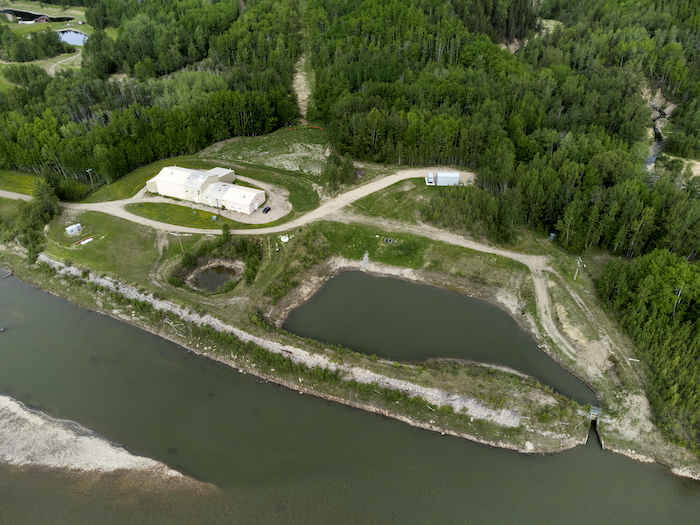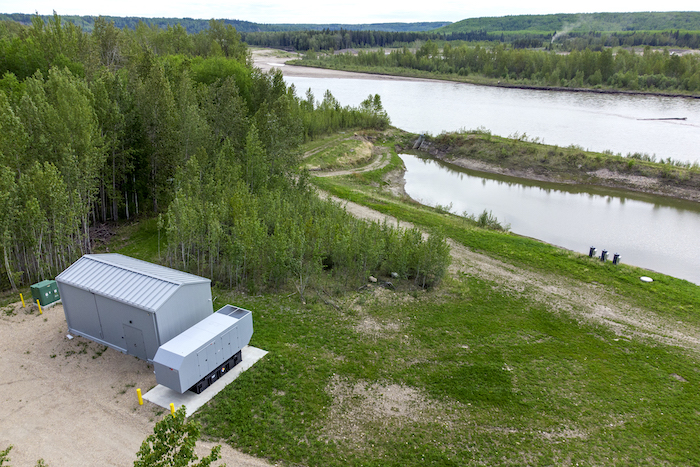
2022 #CCEawards Showcase: Drayton Valley Raw Water Pump Station
November 5, 2022
By CCE
“A creative way of using existing infrastructure to resolve a budgetary problem.” – Jury
Category: Project Management
Award of Excellence Winner: ISL Engineering and Land Services
Communities have grown along the North Saskatchewan River’s banks for its drinking water and recreational opportunities. Situated on these banks, the town of Drayton Valley’s original water treatment plant (WTP) was abandoned in place, left solely to pump raw water to a new WTP.
Two concerns became increasingly apparent. First, without storage for raw water, rising levels occasionally bypassed the protective berms surrounding the old WTP, compromising the town’s drinking water supply for weeks at a time. Second, it became prohibitively expensive to maintain.
It was clear Drayton Valley needed a new raw water pump station. This need led to the first-ever implementation of a Canadian Construction Documents Committee (CCDC) 30 Integrated Project Delivery (IPD) Contract for a municipal infrastructure project.
The team, including ISL, focused on the client’s most important need: securing the town’s water source from the routine contamination brought on by flooding, thus providing a reliable source of clean drinking water for more than 7,000 residents.
The operation’s first objective was to supply enough raw water to meet the new WTP’s capacity requirement, allowing the town to focus on securing funding. ISL’s experience with similarly sized projects suggested it warranted approximately $6 million for a conventional build, before design costs, but Drayton Valley was only able to secure $4.2 million. The town’s best value would come from IPD, with collaboration from all parties (owner, consultant, general contractor, major sub-consultants and major trades) throughout each project phase.
Designing a visually unobtrusive pump station on a flood plain carried substantial challenges, particularly with the lower budget. The mission changed from building a fully encompassing pump station as its own independent building to determining how to move water from the river up to the new facility, 96 m above water level and 2.2 km west of the river.
Highs and lows
Despite its newly commissioned and operational WTP, the town risked losing its water supply without a new pump station. In high flow years, significant flooding compromised the community’s raw water supply. Contamination events were costly and difficult to manage. The design needed to ensure the pump could operate in both high and low flow years.
Owing to the building’s location in a flood plain and its relative age, it had high operational costs. The town started decommissioning the old WTP in the mid-2010s, yet even once the new facility was online, the town still had to maintain the old one to pump raw water.
The site posed topographical challenges, building on a flood plain, adjacent to both a steep hillside and a river. Navigating a steep hillside limited construction equipment access.

Water needed to be moved up to the new facility, 96 m above water level and 2.2 km west of the river. Photo courtesy ISL Engineering and Land Services.
Finding efficiencies
The contract naturally aligned with target value delivery (TVD), a management practice that encourages lean design strategies to answer clients’ needs within fixed budget constraints. This included streamlining roles, such as having the construction project manager double as the superintendent.
The team collaborated in live estimating sessions using market data. This helped set the project schedule and eliminate waste by only providing the implementation drawings the construction team needed, avoiding unnecessary iterations and eliminating the need to design for multiple outcomes.
Another solution that reduced capital costs was using non-traditional submersible pumps found in the oil industry and as downhole pumps in more turbid environments. As a result, the new pump station functions even when fully submerged in a flood.
Benefits of IPD
The collaborative design process enabled unconventional solutions, like separating mechanical and electrical components that are traditionally in one building. This helped the pump station resist flooding and reduced the excavation work, capital costs and overall carbon footprint.
Creative solutions arising from IPD collaboration saved the town 35% (or $1.8 million) on total capital costs. ISL also minimized future costs by designing the system with low complexity, so exclusive, skilled operators would not be needed to run and maintain the new facility.
ISL reused as much existing infrastructure as possible, which reduced construction costs and the project’s carbon footprint and extended the infrastructure’s operational life. The team also repaired the gravel access road and connected a 2.2-km fibre optic line to existing wastewater ultraviolet (UV) infrastructure, enabling remote monitoring instead of costlier daily inspections.
Through extensive transient analysis and water hammer modelling, ISL controlled the pressure surges that would wear down components. Using the existing steel well casing—and not installing a concrete wet well—saved on concrete, eliminated the need for deep excavation and mitigated slope slippage risks in an unstable area.
The team used a spider plough to install the fibre optic line, further reducing the need for open excavation and minimizing habitat disturbances. The visually unobtrusive pump station did not look like traditional, unappealing models. No added costs were incurred and all work was included in the project budget.
A local success
Drayton Valley’s new pump station supplies raw water to a facility that treats up to 18 million L per day (MLD), with 2,800 m3 of additional potable water storage. The team completed the project with the lowest possible capital costs, reduced future operational costs and, whenever possible, favoured local services, trades and vendors to keep money within the community.
Moving beyond traditional ideas also benefited the town esthetically. The design provides unhindered scenery, for users enjoying the natural beauty of the river, compared to typical pump stations, which also often attract unwanted attention, like vandalism, theft and other petty crimes.
Drayton Valley Raw Water Pump Station, Rocky Rapids, Alta.
Award-winning firm (prime consultant): ISL Engineering and Land Services, Edmonton. (Jason Kopan, P.Eng.; Deon Wilner, P.Eng., CCCA; Greg Germain, P.Eng.; Richard Tombs, P.Eng., C.Eng., MIChemE; David Benke, C.E.T.).
Owner: Town of Drayton Valley.
Other key players: Magna IV Engineering (electrical), Chandos/Bird Joint Venture (contractor), J.R. Paine & Associates (geotechnical), Group 2 Architecture (IPD facilitation), Superior Equipment Sales (pump supplier), Goulds Water Technology (pump manufacturer).
